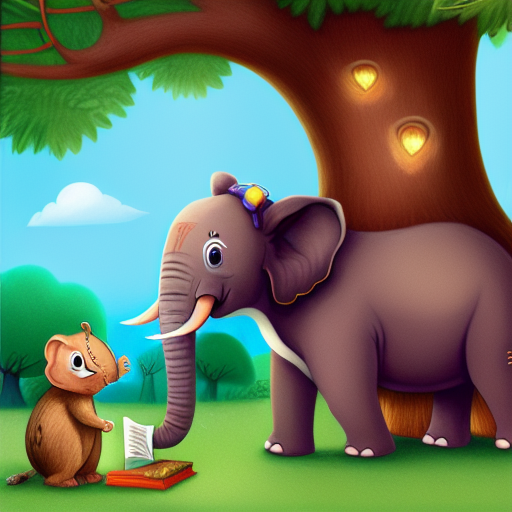Once upon a time, there was an elephant named Ellie. She was a big, gray elephant who loved to play in the forest. One day, Ellie was playing in the forest when she saw a group of squirrels. The squirrels were playing hide-and-seek, and they were having so much fun that Ellie wanted to join in.
Ellie asked the squirrels if she could play with them, and they said yes. Ellie was very good at hide-and-seek, and she even helped the squirrels find each other. The squirrels had so much fun playing with Ellie that they asked her to come back and play with them the next day.
Ellie came back to play with the squirrels every day after that, and they became best friends. They would play hide-and-seek, they would climb trees, and they would even have picnics together.
One day, the squirrels were playing in a tree when they saw a big, mean cat. The cat was chasing a bird, and the squirrels were scared.
“Help!” the squirrels cried. “The cat is going to get us!”
Ellie heard the squirrels calling for help, and she ran over to see what was wrong. When she saw the cat, she knew that she had to do something to help the squirrels.
Ellie picked up the cat with her trunk and threw it away from the squirrels. The cat was so surprised that it ran away.
The squirrels were so grateful to Ellie for saving them. “Thank you!” they cried. “You’re our hero!”
Ellie smiled. “It was my pleasure,” she said. “I’m just glad I could help.”
Ellie and the squirrels continued to be best friends, and they always had each other’s backs. They knew that they could always count on each other, no matter what.
Google The Bard
The Bard in this story is actually the story teller. Google Bard is trained on a massive dataset of text and code, including books, articles, code, and other forms of creative text. This dataset allows Bard to learn about the different ways that stories are told, the different elements that make up a story, and the different styles of storytelling.
In addition to the dataset, Bard is also trained on a set of rules and guidelines for storytelling. These rules and guidelines help Bard to understand what makes a good story, and how to avoid common storytelling mistakes.
The training process for Bard is still ongoing, and it is constantly being updated with new data and new rules. This allows Bard to improve its storytelling skills over time.
Here are some of the specific things that Google Bard is trained on to tell stories:
- The structure of stories. Bard learns about the different parts of a story, such as the setting, the characters, the plot, and the resolution.
- The elements of stories. Bard learns about the different elements that make up a story, such as conflict, suspense, and resolution.
- The styles of storytelling. Bard learns about the different styles of storytelling, such as epic, mystery, and romance.
- The rules of storytelling. Bard learns about the rules of storytelling, such as the three-act structure and the rule of three.
The training process for Google Bard is very complex, and it involves a lot of different factors. However, the goal of the training process is to create a language model that can tell stories that are both engaging and informative.
AI is changing the way stories are told
Artificial intelligence (AI) is already having a significant impact on the way stories are told. AI-powered tools are being used to create new forms of storytelling, and to improve the quality of traditional storytelling.
AI is creating new forms of storytelling. AI-powered tools are being used to create interactive stories, branching narratives, and even virtual reality experiences. These new forms of storytelling allow the audience to have a more immersive and interactive experience.
AI is improving the quality of traditional storytelling. AI-powered tools are being used to help writers with tasks such as plot development, character development, and dialogue. This can help writers to create more engaging and believable stories.
AI is making stories more accessible. AI-powered tools are being used to translate stories into different languages, and to create audio and visual versions of stories. This makes stories more accessible to people who may not be able to read them in their native language, or who may have difficulty reading.
AI-powered tools will be used to create even more immersive and interactive experiences, and to improve the quality of traditional storytelling.
These are just a few examples of how AI is being used to change storytelling. As AI continues to develop, it is likely to have an even greater impact on the way stories are told. To learn more about google bard click here.
At the very least, Google Bard gives me the ability to come up with much better stories for my toddler at bedtime.
As such, The Elephant, the Squirrels and the Bard all live happily ever after.
The end.
….. but is it?



